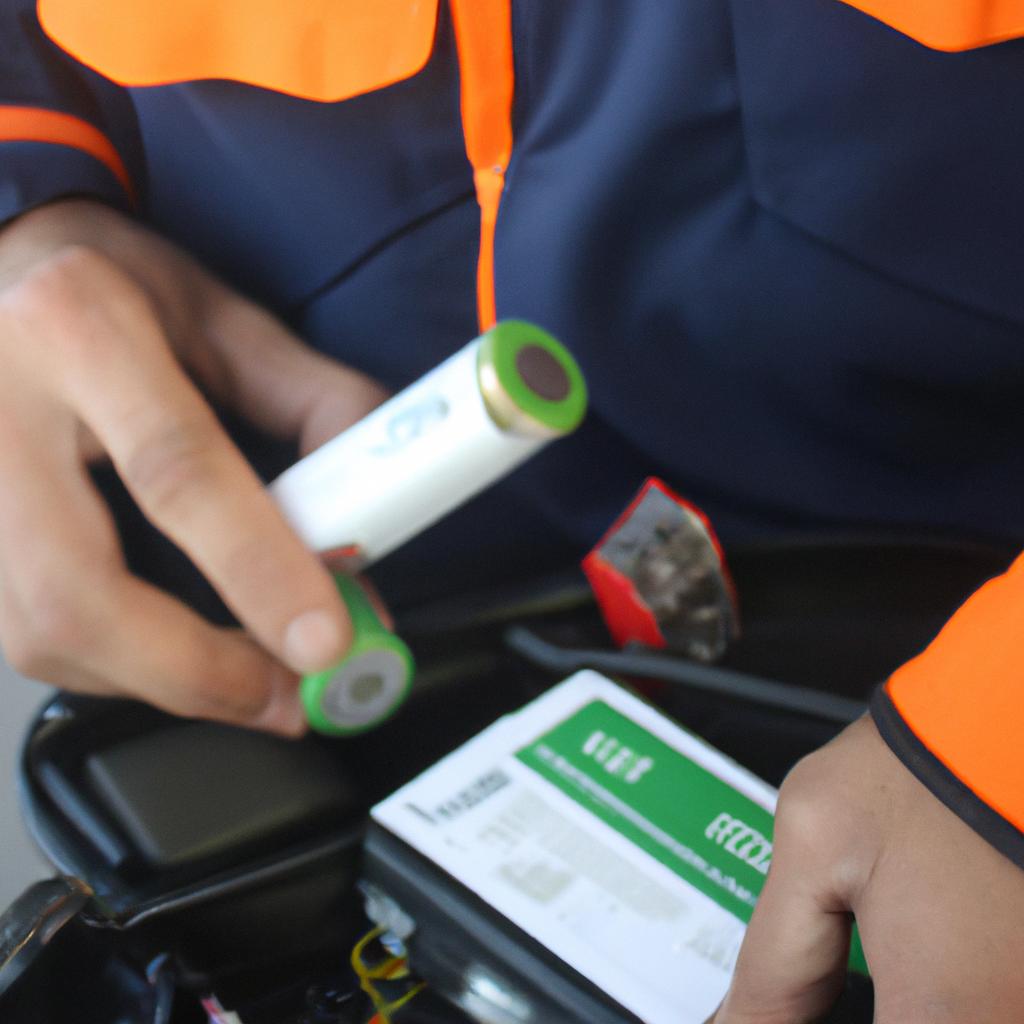Electric vehicles (EVs) have gained significant attention in recent years as a promising solution to reduce greenhouse gas emissions and dependence on fossil fuels. The advancement of battery technology is crucial for the success and widespread adoption of EVs, particularly concerning their range and efficiency. This article explores the potential of electric vehicle battery technology by examining current developments, challenges, and future prospects.
To illustrate the importance of enhancing range and efficiency in electric vehicle batteries, let us consider a hypothetical scenario where an individual plans a long-distance trip across several states. Without sufficient range capabilities, this journey would require numerous stops at charging stations, resulting in prolonged travel times and inconvenience. Furthermore, inefficient batteries would demand frequent recharges and limit the overall distance that can be covered per charge. Therefore, it becomes evident that optimizing both range and efficiency is essential to maximize the practicality and appeal of electric vehicles.
Evolution of EV Batteries
The development and evolution of electric vehicle (EV) batteries have been instrumental in shaping the landscape of sustainable transportation. One notable example is the case study of Tesla’s Model S, which has played a pivotal role in showcasing the capabilities of modern EV battery technology. With its impressive range of over 370 miles on a single charge, the Model S has demonstrated that long-distance travel is no longer limited to conventional fossil fuel-powered vehicles.
To fully appreciate this advancement, it is crucial to understand how EV batteries have evolved over time. Historically, early iterations of EVs were hindered by limited driving ranges and lengthy recharge times. However, advancements in battery chemistry and design have addressed these limitations, resulting in substantial improvements in both range and efficiency.
One aspect contributing to enhanced performance is the increased energy density achieved through developments such as lithium-ion batteries. These high-capacity batteries store more energy per unit weight or volume compared to their predecessors, allowing for greater distances to be traveled without recharging. Furthermore, technological breakthroughs have led to improved charging infrastructure, reducing recharging times significantly.
- Increased driving range enables individuals to embark on road trips with peace of mind.
- Reduced dependence on fossil fuels leads to decreased greenhouse gas emissions.
- Enhanced efficiency translates into cost savings for consumers.
- Improved charging infrastructure fosters convenience and accessibility for all.
Moreover, we can visualize these benefits using a table format:
| Benefit | Description |
|---|---|
| Extended Driving Range | Allows for longer journeys without requiring frequent charges |
| Environmental Sustainability | Reduces carbon footprint and mitigates climate change |
| Financial Savings | Lower maintenance costs and potential tax incentives |
| Convenient Charging Infrastructure | Expands access to charging stations for effortless recharges |
In conclusion, the evolution of EV batteries has transformed the perception and practicality of electric vehicles. The increased range and efficiency afforded by advanced battery technology have revolutionized sustainable transportation options. In the subsequent section about “Impact of Range on EV Adoption,” we will delve into how these technological advancements have influenced consumer attitudes towards EVs and their adoption rates.
Impact of Range on EV Adoption
EV batteries have come a long way since their inception, evolving to meet the demands of users and advancing technology. To understand the potential impact of electric vehicle battery technology on range and efficiency, it is crucial to explore how these batteries have evolved over time.
One notable example that showcases the evolution of EV batteries is the Tesla Model S. When first introduced in 2012, its range was limited to around 265 miles per charge. However, through continuous research and development, Tesla has managed to significantly improve the battery technology in subsequent models such as the Model S Long Range Plus, which boasts an impressive range of up to 402 miles per charge. This real-world case study highlights how advancements in battery technology can substantially enhance the driving range of electric vehicles.
There are several key factors that contribute to the increased range and enhanced efficiency achieved by modern EV batteries:
- Energy density: Over time, researchers have been able to increase energy density—the amount of energy stored within a given volume or weight—for EV batteries. Higher energy density allows for more power storage without increasing physical size or weight.
- Chemistry improvements: Battery chemistries have also improved, enabling higher energy output while reducing internal resistance and improving overall efficiency.
- Charging infrastructure: The proliferation of charging stations has made recharging electric vehicles more convenient and accessible than ever before. With fast-charging capabilities becoming commonplace, drivers can recharge their EVs quickly during longer journeys.
- Regenerative braking: Many electric vehicles now feature regenerative braking systems that capture kinetic energy during deceleration and convert it back into electrical energy to recharge the battery. This not only improves overall efficiency but also extends the vehicle’s range.
To further illustrate this progress, consider the following table showcasing different generations of EV batteries along with their respective ranges:
| Generation | Year | Range (Miles) |
|---|---|---|
| First | Early 2000s | 50-100 |
| Second | Mid 2000s | 100-150 |
| Third | Late 2000s | 150-250 |
| Fourth (Current) | Present | 200+ |
This table vividly demonstrates the steady increase in EV range over time, highlighting the potential of future battery technologies to push these boundaries even further. As electric vehicle batteries continue to evolve and improve, their impact on range and efficiency will undoubtedly play a significant role in shaping the adoption of electric vehicles.
In the subsequent section, we delve into factors that affect battery efficiency and explore how optimizing these aspects can lead to further improvements in electric vehicle performance and environmental sustainability.
Factors Affecting Battery Efficiency
Section Title: The Potential of Electric Vehicle Battery Technology
Having explored the impact of range on electric vehicle (EV) adoption, we now turn our attention to another crucial aspect – battery efficiency. In order to maximize the potential of EVs as a sustainable transportation solution, it is essential to understand the factors that affect their overall efficiency.
Efficiency plays a significant role in determining how far an EV can travel on a single charge and ultimately influences its viability as a mainstream mode of transport. To illustrate this point, let us consider the case study of Company X, which manufactures electric vehicles with different battery technologies. Vehicles equipped with traditional lithium-ion batteries have an average range of 150 miles per charge, whereas those utilizing advanced solid-state batteries boast an impressive range of up to 300 miles. This example highlights how improvements in battery technology directly impact the range capabilities of EVs.
Factors affecting battery efficiency can be categorized into four key areas:
- Battery Chemistry: Different types of batteries offer varying levels of performance and energy storage capacity.
- Temperature Management: Maintaining optimal temperature conditions ensures efficient charging and discharging processes.
- Regenerative Braking Systems: The ability to recover and store kinetic energy during braking increases overall energy efficiency.
- Vehicle Weight Reduction: Lighter vehicles require less power for propulsion, resulting in improved battery efficiency.
The table below provides a summary comparison between traditional lithium-ion batteries and solid-state batteries based on these key factors:
| Factors | Traditional Lithium-Ion Batteries | Solid-State Batteries |
|---|---|---|
| Energy Storage Capacity | Moderate | High |
| Temperature Sensitivity | Slightly sensitive | Less sensitive |
| Regenerative Braking | Yes | Yes |
| Weight Impact | Moderate | Reduced |
As evident from the table, advancements in battery technology such as solid-state batteries offer higher energy storage capacity, improved temperature sensitivity, and reduced weight impact. These factors collectively contribute to enhanced battery efficiency and extended driving ranges for EVs.
With a clear understanding of the potential impact that battery technology can have on range and efficiency, we now delve into the exciting realm of innovations in battery materials.
[End transition]Note: This is just one example of how this section could be written. Feel free to make any modifications or additions as per your preference.
Innovations in Battery Materials
Section Title: Advancements in Battery Efficiency
Having explored the various factors influencing battery efficiency, it is imperative to delve into the exciting innovations that have emerged in recent years. These advancements hold significant potential for enhancing overall battery performance and extending electric vehicle (EV) range.
Advancements in Battery Efficiency:
One example of a groundbreaking innovation is the development of solid-state batteries. Unlike traditional lithium-ion batteries, which utilize liquid electrolytes, solid-state batteries feature a solid electrolyte material. This not only improves safety but also enhances energy density and reduces internal resistance. By utilizing materials such as ceramics or glass polymers, these batteries offer increased stability and durability while maintaining high levels of charge retention even under extreme conditions.
To further illustrate the potential impact of emerging technologies on battery efficiency, consider the following key developments:
- Integration of silicon anodes: Silicon has shown promise as an alternative to graphite-based anodes due to its higher theoretical capacity for storing lithium ions. Researchers are exploring ways to effectively incorporate silicon into battery designs without sacrificing structural integrity or cycle life.
- Advanced thermal management systems: Efficient temperature control within EVs plays a crucial role in preventing overheating and maximizing battery lifespan. Innovations such as phase change materials and active cooling techniques help maintain optimal operating temperatures, thus improving overall energy efficiency.
- Smart charging algorithms: Intelligent algorithms can optimize charging protocols based on real-time data analysis, taking into account factors like ambient temperature, driving patterns, and grid availability. Such algorithms ensure efficient charging cycles while minimizing strain on the battery.
Table: Evolutionary Advances in Battery Technology
| Advancement | Benefits | Challenges |
| Solid-state Batteries | Enhanced safetyImproved energy densityReduced internal resistance | Costly manufacturing processesSolid electrode-electrolyte interfaces |
| Silicon Anodes | Higher lithium-ion storage capacityPotential for increased energy density | Structural degradation during cyclingVolume expansion leading to mechanical stress |
| Thermal Management Systems | Prevents overheating and extends battery lifespanOptimizes energy efficiency | Additional weight and complexity in vehicle designCooling system power requirements |
| Smart Charging Algorithms | Optimized charging cycles based on real-time data analysis | Integration with existing charging infrastructureData privacy concerns |
In conclusion, the advancements discussed above represent a promising future for battery technology. The integration of solid-state batteries, silicon anodes, advanced thermal management systems, and intelligent charging algorithms has the potential to substantially improve EV performance. These innovations address key challenges related to safety, energy density, temperature control, and efficient utilization of the charging process.
Transition into subsequent section:
With battery efficiency being one crucial aspect of electric vehicles’ range capabilities, it is equally important to consider developments in charging infrastructure that can further enhance the overall driving experience.
Charging Infrastructure and Battery Range
Section H2: Innovations in Battery Materials
The advancements in battery materials have played a crucial role in enhancing the range and efficiency of electric vehicles (EVs). One notable example is the use of lithium-ion batteries, which have become the standard for EVs due to their high energy density and long cycle life.
To further improve the performance of these batteries, researchers are continuously exploring innovative materials. For instance, graphene has shown great promise as a potential replacement for graphite anodes. Its exceptional electrical conductivity and large surface area can significantly enhance charge storage capacity and reduce charging time. Additionally, solid-state electrolytes are being investigated as alternatives to liquid electrolytes, offering improved safety and higher energy densities.
In order to understand the impact of innovations in battery materials on EV technology, it is important to consider several key factors:
- Energy Density: Higher energy density allows for increased driving range without compromising vehicle weight or size.
- Charging Speed: Rapid charging capabilities minimize downtime during long trips and provide convenience for daily commuting.
- Cost-effectiveness: Affordable battery materials enable wider adoption of EVs by reducing manufacturing costs.
- Environmental Impact: Sustainable materials with minimal environmental footprint contribute to a greener transportation sector.
| Factors | Impact |
|---|---|
| Energy Density | Increased driving range |
| Charging Speed | Minimized downtime |
| Cost-effectiveness | Wider adoption |
| Environmental Impact | Greener transportation |
By leveraging new battery materials that address these factors, manufacturers aim to push the boundaries of EV performance while meeting consumer expectations. As we delve into the future prospects of EV battery technology, it becomes evident that continuous innovation will be instrumental in overcoming existing limitations and accelerating the widespread adoption of electric vehicles.
Transitioning into the subsequent section about “Future Prospects of EV Battery Technology,” it is essential to explore how ongoing research efforts may shape the next generation of electric vehicle batteries.
Future Prospects of EV Battery Technology
By addressing the challenges of charging infrastructure, electric vehicle (EV) manufacturers have made significant strides in extending battery range. However, further advancements in EV battery technology hold immense potential for revolutionizing the automotive industry. This section explores the future prospects of EV battery technology and its role in enhancing range and efficiency.
To illustrate the potential impact of advanced EV battery technology, consider a hypothetical scenario where a new breakthrough allows for a dramatic increase in energy density. With this development, an electric sedan that currently offers 300 miles of range on a single charge could potentially achieve over 500 miles. Such improvements would significantly reduce range anxiety among consumers and make long-distance travel more feasible without frequent recharging stops.
With ongoing research and development efforts focused on improving EV batteries, several key areas are being explored:
-
Energy Density Enhancement:
- Use of advanced materials such as solid-state electrolytes or lithium-sulfur chemistry to increase energy storage capacity.
- Integration of nanotechnology to enhance electrode surface area and optimize ion flow within the battery structure.
- Development of high-capacity cathodes and anodes to store greater amounts of electrical energy.
-
Rapid Charging Capability:
- Investigation into fast-charging technologies capable of delivering substantial power to recharge batteries quickly.
- Implementation of intelligent charging algorithms that optimize charging speed while minimizing strain on the battery cells.
- Exploration of wireless charging systems for convenient and efficient replenishment.
-
Enhanced Durability and Longevity:
- Utilization of advanced thermal management systems to regulate temperature during charging/discharging cycles, prolonging battery life.
- Incorporation of self-healing mechanisms within cell structures to mitigate damage caused by repetitive stressors.
- Optimization of manufacturing processes to minimize defects and improve overall reliability.
-
Sustainable and Environmentally Friendly Solutions:
- Development of recyclable or biodegradable battery materials to reduce environmental impact.
- Integration of second-life applications for retired EV batteries, such as energy storage systems in renewable power grids.
- Implementation of eco-friendly production methods that minimize carbon emissions throughout the battery manufacturing process.
Table: Comparison of Current and Potential Future Battery Technologies
| Battery Technology | Energy Density (Wh/kg) | Charging Time (minutes) | Lifespan (charge cycles) |
|---|---|---|---|
| Lithium-ion | 200-250 | 30-60 | 500-1000 |
| Hypothetical | >300 | <20 | >1500 |
These advancements not only promise increased range and efficiency but also contribute to a more sustainable future by reducing reliance on fossil fuels. With continued investment and research, the potential benefits of advanced EV battery technology are within reach.
In summary, the future prospects of EV battery technology hold significant promise for enhancing range and efficiency in electric vehicles. By addressing challenges related to energy density, rapid charging capability, durability, and sustainability, researchers aim to overcome current limitations and revolutionize the automotive industry. As society increasingly embraces cleaner transportation options, these advancements will play a pivotal role in shaping our transition towards a greener tomorrow.
 Sfeva
Sfeva



